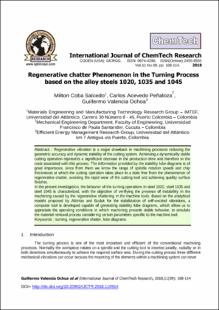Regenerative chatter Phenomenon in the Turning Process based on the alloy steels 1020, 1035 and 1045
...
Coba Salcedo, Milton Fabian | 2018
Regenerative vibration is a major drawback in machining processes reducing the
geometric accuracy and dynamic stability of the cutting system. Achieving a dynamically stable
cutting operation represents a significant decrease in the production time and therefore in the
costs associated with this process. The information provided by the stability lobe diagrams is of
great importance, since from them we know the range of spindle rotation speeds and chip
thicknesses at which the cutting operation takes place in a state free from the phenomenon of
regenerative chatter, avoiding the rapid wear of the cutting tool and achieving quality surface
finishes.
In the present investigation, the behavior of the turning operations in steel 1020, steel 1035 and
steel 1045 is characterized, with the objective of verifying the presence of instability in the
machining caused by the regenerative chattering in the machine tools. Based on the analytical
models proposed by Altintas and Budak for the stabilization of self-excited vibrations, a
computer tool is developed capable of generating stability lobe diagrams, which allow us to
appreciate the operating conditions in which machining presents stable behavior, to simulate
the material removal process considering certain parameters specific to the machine tool.
LEER










